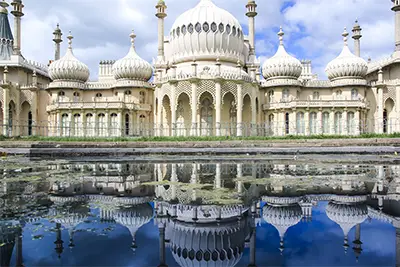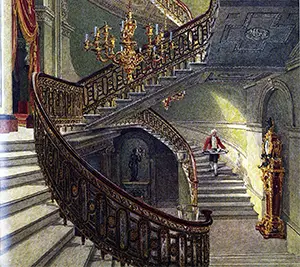Wednesday, August 13, 2025 King George IV of Great Britain and Ireland
George IV was the last of the Hanoverian kings of Great Britain named George. He reigned as regent for nine years and monarch for ten, in the early 19th Century. 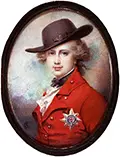
He was born on Aug. 12, 1762, at St. James' Palace, in London. He was the oldest son of the current monarch, King George III and was Duke of Cornwall and Duke of Rothesay right away and Prince of Wales and Earl of Chester not long afterward. A strong student (except for an appalling ability to misspell words), he studied under private tutelage, enjoying Shakespeare and quickly mastering French, German, and Italian. Two things that Prince George became very good at were spending money lavishly and embarrassing his father, the king. Prince George moved into his London residence, Carlton House, at age 21 and, despite getting a hefty allowance from his father and being given a large sum of money from Parliament, spent himself into large amounts of debt. He spent money on clothes, food, drink, and parties. He kept on doing so for the rest of his life. One of the most objectionable things, at least to his pious father and to many others in the government, that Prince George did was get married, in 1785. His new wife was Maria Fitzherbert, who had, according to the mores of the time, three strikes against her: she was a Catholic, she had been divorced twice, and she was a commoner. Nonetheless, George was in love with Maria, and Maria he married. King George did not approve, but that didn't bother Prince George. He should have worried because the Royal Marriages Act 1772 required the king's consent to a marriage of his child. As well, Prince George could not succeed his father on the throne as long as he was married to a woman of the Catholic faith. The Act of Settlement 1701 had specifically prohibited a Catholic monarch or a ruler whose spouse was Catholic. As long as George was married to Maria, he could never be king. George didn't much care, so in love was he with his new wife and his lifestyle. However, he eventually found a reason to change his mind. In 1787, with his relationship with his father at an ebb and his debt the exact opposite, Prince George appealed to his friends in Parliament (for he had a few, who sought to exploit the division between father and son by cozying up to the Prince of Wales) for financial assistance. George's friends came through with a large sum of money, so that the prince could clear most of his debts and even have a little left over to spruce up Carlton House even more. The one condition was that he publicly declare his marriage at an end. George reluctantly did so, and Maria was sent away. 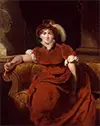
The prince hadn't learned his lesson with regard to spending, however, and he was once again in a large amount of debt a few years later. The condition this time, of both his friends in Parliament and of his father, was that he marry someone of their choosing. Again, George chose to take the money. This time, he married his cousin, Princess Caroline of Brunswick. George clearly didn't want to marry Caroline and took little interest in the preparation or the ceremony itself, having to be reminded by the celebrant to complete his promises. The royal couple never got along yet somehow managed to have a daughter, Princess Charlotte. George and Caroline separated not long after Charlotte was born and never reconciled. 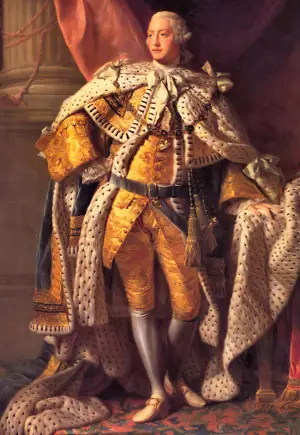
King George III had developed a health condition that worsened from physical symptoms into mental illness. Historians still differ as to the exact nature of the various maladies that plagued the king. Many people think that the king suffered from the porphyria, a disease of the kidneys. The first occasion of the king's incapacitation occurred in November 1788. He was so removed from reality that the leaders of government considered naming Prince George the Prince Regent then. Prince George's supporters insisted on giving the prince the full power of kingship. Prime Minister William Pitt (the Younger) refused, and haggling over the nature of the regency lasted until the king had recovered his faculties. Again in 1801 and 1804, the king suffered brief fits of incapacitation. It was clear by 1811, however, that he was no longer fit to rule. The death of his daughter Amelia the year before had sent him into a mental tailspin from which he never really recovered. 
On Feb. 5, 1811, Prince George became Prince Regent of Great Britain and Ireland. The newly named regent responded with an extravagant party to celebrate his new status. George had early developed a keen interest in fashion and a keen fascination in the specific look of a junior officer in the 10th Hussars named George "Beau" Brummell. Brummell epitomized the term "dandy," with his linen shirts, cravats, trousers, and long shiny boots. Prince George adopted Brummell as his fashion idol and encouraged others to dress accordingly. Women also during this changed the way they dressed. Out of favor were elaborate wigs and loads of face powder. In were stylish hair and pale, unpowdered faces. In as well were high-wasted gowns of muslin and low heeled shoes that resembled nothing so much as slippers. All of that clothing was designed to be seen, and George encouraged the throwing of lavish parties. Among his usual companions at lavish gatherings were Brummell, the playwright Richard Brinsley Sheridan, and Whig Opposition leader Charles Fox.
Architecture, too, fascinated Prince George, and he commissioned architect John Nash and others to build lavish living and breathing spaces. Nash upgraded Buckingham House to Buckingham Palace. He also upgraded Carlton House (above right), George's London mansion, and Brighton Pavilion (above left), George's residence on the sea. Nash also redesigned Regent's Street and Regent's Park, adding a canal to the elegant collection of townhouses and villas, terraces and gardens. Another famous architect, Sir Jeffry Wyatville, rebuilt Windsor Castle. Other developments took place in Bath and Cheltenham. All of this clothing and construction cost enormous sums of money, of course, and Prince George was always happy to pass on the bill to others in the government. Once he was Prince Regent, the leaders of the government discouraged him from taking part in the business of government and so he was free to spend even more time on lavish pursuits. Chronicling all of this high society in novels based in fact was the celebrated author Jane Austen, whose Pride and Prejudice, Sense and Sensibility, and Emma captured the era in often stark detail. George IV was said to be a fan of Austen's novels. By royal command, she dedicated Emma to him. Ostensibly, the Prince Regent was meant to carry in the functions that his father had been performing. Those were considerable because King George III had played an active role in the prosecution of both the Revolutionary War and the Napoleonic Wars and was very much involved with Cabinet proceedings. As in his moral outlook, Prince George was the polar opposite of his father, choosing to stay out of governmental affairs altogether. Even the assassination of Prime Minister Spencer Perceval in 1812 could not convince the Prince Regent to get involved in the running of the country. He was much more interested in his lavish lifestyle, which was making him ever more fat as the years went by. 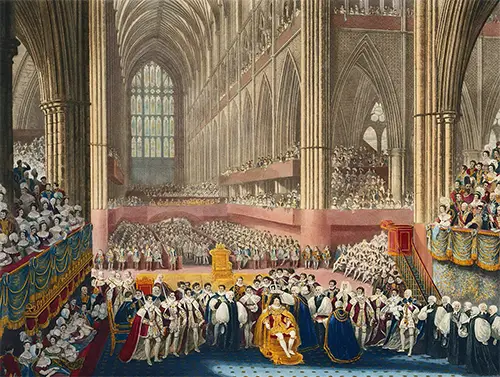
The king died on Jan. 29, 1820. The Prince Regent became King George IV. Continuing with his tastes, he ordered a very expensive coronation. It was very well attended, and the king found himself popular despite his previous outrageous behavior. Still separated from Caroline, George refused to allow her to attend his coronation. She tried to attend anyway but was rebuffed by security forces. She died the following year. Princess Charlotte had died in 1817, of complications of childbirth. The new king went on a royal tour of his realm, becoming the first monarch to visit Ireland since Richard II and the first to visit Scotland since Charles II. In his later years, George amassed a large art collection, storing the contents in Buckingham Palace and Windsor Castle. He continued to appreciate the finer things in life, but his years of hard living caught up with him. In his last years, he suffered from gout and was so overweight that, fearing public ridicule, he kept to the royal residence for most of his waking hours. He died of a heart attack on June 26, 1830. George had been his father's oldest son. His younger brother Frederick had died in 1827, to George IV was succeeded by his surviving brother, who became William IV. Also occurring during the reign of George IV:
|
|
Social Studies for Kids
copyright 2002–2024
David White



